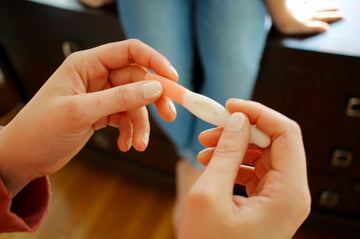How to use an early pregnancy test: A complete guide

If you're taking a pregnancy test for the first time or just want to better understand how they work, look no further — here’s our comprehensive guide to pregnancy tests.
How do early pregnancy tests work?

When you get pregnant, your body starts to produce a hormone called human chorionic gonadotropin (hCG). This hormone shows up in your urine about 10 days after the egg is fertilized and implants in your uterus. The levels of hCG will increase rapidly in your first 10 weeks of pregnancy.
Our Early Detection Pregnancy Test works by detecting the level of hCG in your pee, which determines if you are pregnant or not. Two lines on the pregnancy test mean that your urine is positive for the hCG hormone and you are pregnant. Just one line means your urine is negative for hCG and you are not pregnant.
Common questions about pregnancy tests
If you have questions about taking a pregnancy test, that’s normal! Here's a quick roundup of the most commonly asked questions about pregnancy testing.
When should I take a pregnancy test?
With our early-detection pregnancy tests, you can begin testing for pregnancy as soon as 6 days before your missed period.
It’s important to know that if you test too early in your cycle, though, there may not be enough hCG for an at-home test to detect, which can lead to a false negative result.
That's why we suggest waiting until the first day of your missed period to use an at-home pregnancy test. After conception, the hCG pregnancy hormone starts to double every 2 to 3 days, so if you hold off testing until the day of your missed period, you’ll have better chances at having an accurate result.
If you just can’t wait to take a test, it’s always a good idea to take a second pregnancy test a few days later to help confirm your results.
What if I have an irregular period?
If you have an irregular period or your period has stopped due to birth control, you can take a pregnancy test about 19 days after having sex.
What time of day should I take a pregnancy test?
You’re more likely to get an accurate result if you take a pregnancy test in the morning before you drink any liquids, so your coffee or tea will have to wait!
Unless you get up in the night to pee often or you drink water throughout the night, your hCG levels will be strongest first thing in the morning. Drinking something before you take a pregnancy test can dilute your urine and make it harder to get an accurate reading.
Your test will still be valid if it’s the afternoon or you’ve already had water, but first-morning urine will result in a stronger results line. The stronger the line, the more accurate the pregnancy test results.
Can I use a pregnancy test while taking birth control?
Good news: birth control does not interfere with the results of your pregnancy test. If you’re currently on birth control and aren’t sure if you’re pregnancy, it’s best to take a test for peace of mind.
What can affect my pregnancy test results?
A few things can affect the accuracy of your pregnancy test. If you were recently pregnant, have a condition like ovarian cysts, or are taking a drug that contains hCG, you can get a false positive result. We recommend chatting with your primary care provider if this applies to you.
What doesn’t affect the results of my pregnancy test?
If you’ve recently drank alcohol, used antibiotics, or taken painkillers, your pregnancy test results won’t be affected. If you’ve used emergency contraception like the morning-after pill in the weeks leading up to when you’re taking a pregnancy test, this will also not interfere with your results.
How to take a pregnancy test
Step 1: Open the foil wrapper and remove the test’s plastic cap.
Step 2: Sit on the toilet, hold the thumb grip, and place the absorbent tip in your urine stream for 10 seconds. (Make sure the results window is facing up!)
You can also dip the absorbent tip in a small cup of urine for 10 seconds instead if that’s easier, too.
Step 3: Put the cap back on and lay the test on a flat, non-absorbent surface with the results window facing up.
Step 4: Wait 5 minutes before reading the results. Before reading your results, take a deep breath. Whether you’re hoping for one line or two, waiting for your pregnancy test results can be stressful.
Don’t read the results after 10 minutes have passed as they will no longer be accurate.
How to read pregnancy test results
Hold the test so the (T) Test window is on the left and the (C) Control window is on the right. The control line confirms the test worked, and the test line (T) measures the level of your hCG hormone.
If there is a line in the test window and the control window

One line in the test window and one line in the control window means you’re likely pregnant, even if the test line is faint. If you see an extremely faint test line, you can test again in 24-48 hours. If you’re pregnant, your hCG levels will continue to increase and the line should appear darker.
If there’s only a line in the control window

One red line in the control window and no line in the test window means you’re likely not pregnant.
If there are no lines (or only a line in the test window)

If you don’t see a control line, the test is invalid (even if there’s a line in the test window). Try taking another test.
Need help?
We’re here for you, every step of the way. . Reach out to us!
Keep Reading

How early can you take a pregnancy test?
Jun 20

When to take a pregnancy test with an irregular period
November 18, 2022

Does PCOS or endometriosis affect pregnancy test results?
Mar 3








